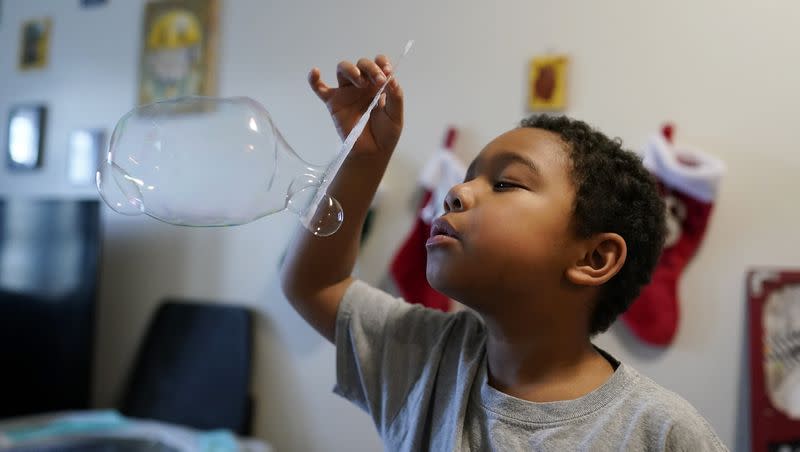New app could fast-track diagnosis of autism

About 1 in 36 children are diagnosed with autism spectrum disorder, or ASD. Though occurring in all racial, ethnic and socioeconomic groups, the prevalence of ASD was lower in white children than in other groups, per the CDC. Furthermore, ASD is four times more common among boys than girls.
For comparison, the previous surveillance year in 2018 found 1 in 44 children to be identified with ASD. Past years show the continued rise in prevalence, according to the CDC.
Since there is no medical test for autism, experts diagnose by looking at developmental history and behavior of the child. Therefore, families often face delayed diagnosis.
Moreover, for girls and children from minority backgrounds, this delay is frequently extended due to challenges in accessing appropriate experts and the variability of symptoms among individuals, according to National Geographic.
However, there may be some hope.
In a study published in Nature Medicine, researchers introduced a digital screening device, which employed machine learning to analyzed different behavioral aspects, assessing the likelihood of a child being autistic.
The screening tool, called the SenseToKnow app, accurately predicted eventual autism diagnoses in a group of 475 children. Performance was similar across sex, race and ethnicity, according to the study.
What are some signs of autism?
The CDC shares examples of characteristics related to ASD:
Avoids or lacks eye contact.
Doesn’t respond to name by nine months.
Doesn’t display facial expressions like happy, sad, angry or surprised by nine months.
Doesn’t engage in simple interactive games like pat-a-cake by 12 months (or one year).
Uses few or no gestures by 12 months (or one year), such as not waving goodbye.
Doesn’t share interests with others by 15 months, such as not showing objects they like.
Doesn’t point to show you something interesting by 18 months.
Doesn’t notice when others are hurt or upset by 24 months (or two years).
Doesn’t engage in pretend play, like pretending to be a teacher or superhero by 48 months (or four years).
Doesn’t sing, dance or perform for you by 60 months (or about five years).
Arranges toys or objects in lines and becomes upset when the order is altered.
Repeatedly echoes words or phrases.
Engages with toys in a consistent manner on every occasion.
Shows intense focus on specific parts of objects, such as wheels.
Becomes distressed by minor alterations.
Displays obsessive interests.
Prefers to adhere to specific routines.
Exhibits hand-flapping, body-rocking or spinning in circles.
Displays unusual responses to sensory stimuli related to sound, smell, taste, appearance or texture.
Delayed language abilities.
Delayed motor skills.
Delayed cognitive or educational skills.
Hyperactivity, impulsiveness and/or inattention.
Epilepsy or seizure conditions.
Atypical eating and sleeping patterns.
Gastrointestinal problems, such as constipation.
Unusual mood swings or emotional responses.
Anxiety, stress or excessive concern.
Lack of fear or heightened fear compared to normal.
Not all children with ASD will have all or any of the behaviors listed above.
Parents will typically look at the characteristics above and report their concerns to pediatricians. The pediatrician will then give a formal screening questionnaire called The Modified Checklist for Autism in Toddlers, Revised with Follow-Up, or M-CHAT-R/F, that includes questions regarding a child’s behavior or development milestones, according to National Geographic.
David Mandell, a professor of psychiatry at the University of Pennsylvania, said to National Geographic, “Of those (children) who screen positive, only half are referred to early intervention.”
How does the SenseToKnow app work?
Parents have their child watch a 10-minute video while the camera records different behaviors. The test determines if the child might be autistic by considering what they focus on in the video, their facial expressions, head movements and how they respond when their name is called, per National Geographic.
Out of the 475 children screened with the SenseToKnow app during a primary care visit, 49 eventually received a diagnosis of autism and 98 were diagnosed with other developmental delays, according to the study published in Nature Medicine.
Are there any limitations to the SenseToKnow app?
The prevalence of autism or developmental delay diagnoses might be attributed to the voluntary participation of the study, as parents concerned about their child’s development likely chose to enroll.
Also, before the SenseToKnow app can be implemented in a primary care setting, it requires additional studies to validate its accuracy across various groups of children. This especially includes Black children as there were low numbers participating in the study, per National Geographic.
Related
